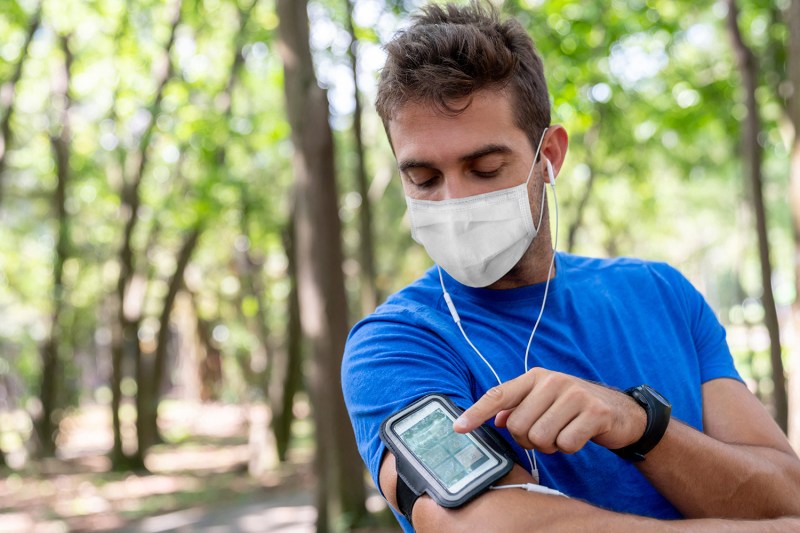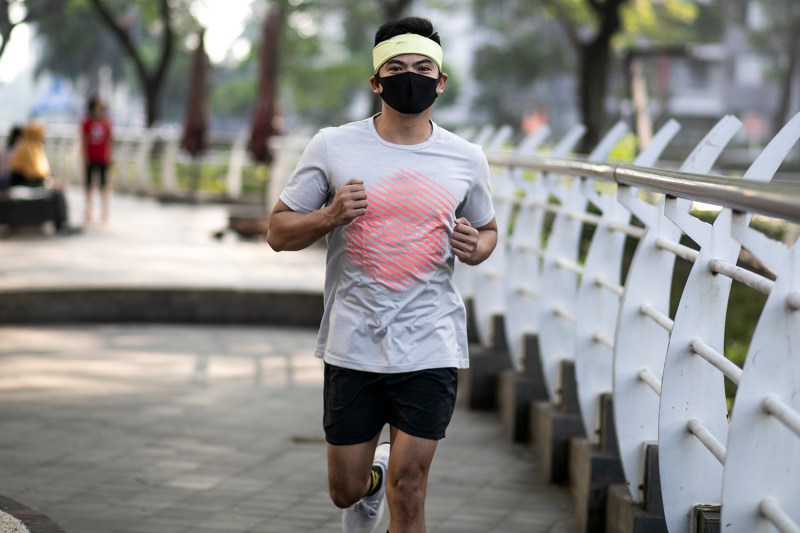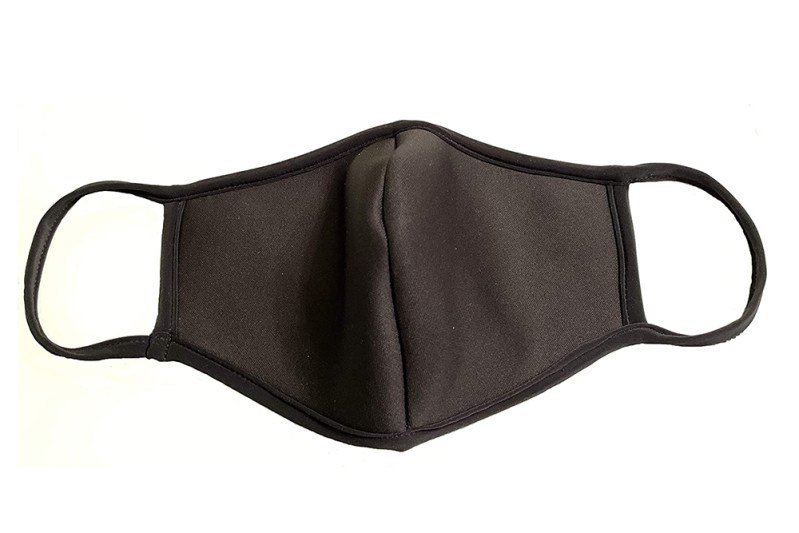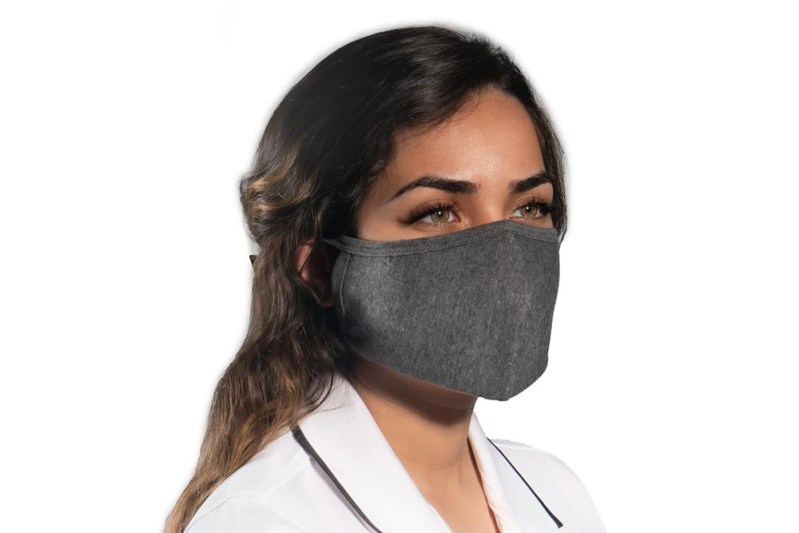
Assuming you’re not a card-carrying agent of the “Freedom to Breathe Agency,” like the rest of us you’re doing your best to follow CDC guidelines: Maintaining social distance, washing your hands often, and wearing a mask. Of course, wearing one when you’re sitting on a park bench or going for a leisurely stroll is one thing. It’s quite another if you’re huffing and puffing during an intense high-intensity workout.
If you’re a runner, hopefully you can get outside to a place where you can maintain some distance from others and only pull on your mask when you find yourself in more heavily populated spaces (assuming it’s not required by your local jurisdiction). As gyms open up, though, wearing a mask indoors will be a requirement at any responsible establishment. We talked to several fitness and medical pros to get some guidance about wearing masks during workouts, what to look for in a mask, and what, if anything, you can do to prepare your body for that first day back at the gym.
You may have seen the recent University of Wisconsin study that analyzed masks for effectiveness. At the top of the ratings was, of course, the vaunted medical N95 mask, which the rest of us are supposed to eschew, allowing supply for the medical, first responder, and essential services personnel who really need them. Second on the list was the classic surgical or dust mask that many of us have been using regularly. The problem with those, as you may have discovered, is that they can get wet and sloppy from sweat and the moisture in our breath, pretty much annihilating their effectiveness.
Matthew Whalen is the Director of Sports Medicine and Head Athletic Trainer of Tufts University in Boston, Mass. He says that, “The challenge is that surgical masks are not good for a workout. They stick to your face when wet. There are masks that have a vent for easy airflow are basically defeating what the mask is for in the first place.”
“Even with medical grade masks, when we are aware that our masks are getting too moist from breathing or sweat, we will take a moment to change to a fresh one,” says Dr. Gabriela Andujar Vasquez, Infectious Disease Physician and Associate Hospital Epidemiologist of Tufts Medical Center, also in Boston. “In general, when you’re working out, if you are sweaty or breathing hard, your masks is going to feel uncomfortable and may end up riding around on your face. If it moves around and doesn’t fit well, it’s not going to be effective.”
Trainer and entrepreneur Will Torres of WillSpace in New York City concurs. “The problem is that, if a mask is doing its job, it needs to catch everything. You’re not going to breathe easily. At this point, I’d avoid doing any kind of intense cardio workout inside in a mask.” Torres uses the example of HEPA filters which are being required of gyms to slow the transmission of the virus through air conditioning. “The filters are pretty dense, but the higher the filtration, the more it taxes the power of the unit. That’s just like our bodies! Aerobic activity requires oxygen.”
Whalen goes on to point out that for their student athlete workouts, Tufts University is following Massachusetts state guidelines, maintaining a 14-foot distance for outdoor training with a high level of activity. “Those are the guidelines, but honestly, I’m a big guy. I don’t have scientific data to back this up, but if I were running, I wouldn’t be surprise if my breath would go even farther than 14 feet.”
“Have you ever watched anybody vape,” asks Torres? “Look how far that goes! Now imagine how far the virus can travel.”

All three professionals agree that mask fit is key. Whalen recommends that if you’re not wearing one while running, at least put it on when somebody comes close, then maybe you’ll get used to wearing it. Dr. Vasquez likes masks that lace behind the head because they usually allow for better adjustment, keeping the mask in place. She also suggests looking for masks with wicking fabrics that will at least keep moisture away from your face during your workout. “You may want to try different masks for different workouts,” she suggests.
While Torres really only thinks you can wear masks during lower intensity workouts like active stretching or weight lifting, when he is working with his clients (outdoors only until Manhattan gyms reopen), he wears a mask and a full face shield, and stands six feet away.
“My concern is that people are going to get too comfortable and not take the appropriate steps,” Torres says. “For sure, if you’re doing something like bench presses, don’t spot your buddy because he’ll be breathing right up into your face!”
Preparing yourself to wear a mask during a session seems to be as simple as just wearing it and getting used to it. Dr. Vasquez suggests that if you start to feel sweaty or uncomfortable, to take a mask break away from people, and go somewhere where you can remove the mask, drink some water, and breathe. Layer in safety measures and, of course, maintain social distancing and hand washing.
Equinox fitness clubs sent an email to its members stating that wearing masks does not significantly decrease blood oxygen levels. You’re not breathing in less oxygen; but there is a slight decrease in oxygen delivery to tissues. Similarly, a 2008 study on surgical masks conducted in Turkey implied that masks don’t lower food saturation or blood oxygen consumption, but having an unhealthy cardiovascular system would. The implication seems to be that if you’re concerned about your cardiovascular health, get in shape at home or outdoors first before returning to training at an indoor gym.
Equinox went on to advise members to try diaphragmatic breathing to make mask wearing more comfortable. “Place hands around your ribcage and expand your lungs, inhaling for eight seconds. Hold for five seconds, then exhale out of your mouth for eight, as if you were fogging a mirror. Repeat this cycle five to eight times.”
While we can’t guarantee complete protection from COVID-19, here are a few masks which may work well for your workout, should you choose to go back to gym workouts.
The Best Face Masks for Workouts
Wicked Sheets Washable Multi-Layer Face Mask

While we don’t love that you can’t choose the color you’ll get, the hues are at least neutral and inoffensive, in white, beige, gray, and blue. The Wicked Sheets mask offers moisture-wicking properties with an asthma and allergy-friendly fabric that is washable and multi-layered. It offers full coverage and ties behind the head.
DewAmor Neoprene Mask

The neoprene layer in this mask offers water resistance, just like a good wetsuit, while the cotton layer offers filtering and comfort with a snug fit.
Boomer Naturals Nano-Silver Masks

These multi-layered masks are treated with a nano-silver coating to kill bacteria, and are good for thirty washings. The soft fabric is a 65/35 cotton/polyester blend. While the company does offer many prints, we prefer the solid knit fabric models for a better fit during a workout.



